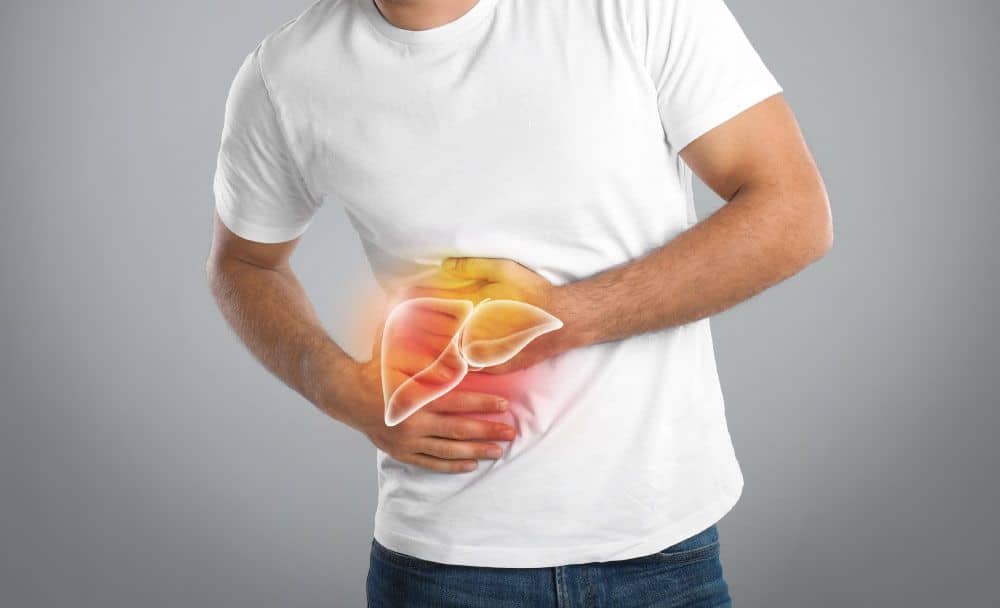Reviewed By Dr. Vipin Bihari Sharma
The liver is the largest internal and one of the most vital human organs. It plays a crucial role in various physiological processes, including the digestion of food, storing energy, and removing toxins. Unfortunately, chronic liver disease has become a significant health concern affecting millions worldwide. It encompasses many conditions that can impair the liver’s normal function and lead to serious health complications. [1] In this article, we will study the chronic liver disease symptoms, types, causes, diagnosis, and treatment.
What are the symptoms of liver diseases?
Liver disease manifests through various symptoms, which can vary depending on the specific type and severity of the condition. Common liver disease symptoms may include jaundice which causes yellowing of skin and eyes, abdominal swelling, bruising easily, and changes in stool and liver disease urine color, among others.[1] Another skin problem related to liver disease that may occur in patients is pruritus which can be protracted and disabling.[5]
What are the types of liver diseases?
There are several types of liver disease, each with its distinct characteristics. Some of the most prevalent types include hepatitis, alcoholic liver disease, fatty liver disease, cirrhosis, and liver cancer. Among the many kinds of liver diseases that can afflict an individual are:
What are the causes of liver damage?
The conditions leading to chronic liver disease can be varied and may be caused by various factors such as viral infections (hepatitis viruses), excessive alcohol consumption, obesity, diabetes mellitus, and tobacco chewing.[3]
How can liver diseases be diagnosed?
Several liver function tests are available to check the proper function of the liver. Tests such as imaging tests such as transient elastography, ultrasound, and magnetic resonance imaging are used to examine the liver tissue and bile ducts. Liver function tests are usually conducted to check for liver damage and help diagnose liver diseases, liver biopsy can be performed to test liver tissue to distinguish between various conditions and tests such as elastography are conducted to reduce the need for biopsy in some situations. [2]
How can liver diseases be treated?
If left untreated, liver diseases can become life-threatening and cause irreversible damage to the liver or bile duct that can become malignant. Liver disease treatment approaches for liver disease depend on the specific condition and its severity. Liver diseases respond to treatment if diagnosed early and are in the beginning stages.[2]
In some cases, lifestyle modifications such as adopting a nutritious diet, exercising regularly, and abstaining from alcohol may be sufficient to manage and control the condition and liver disease symptoms. Medications can be prescribed to alleviate chronic liver disease symptoms, prevent the progression of certain chronic liver diseases, or target the underlying cause.[4]
In more advanced cases, surgical interventions like liver transplantation may be necessary as the only form of liver disease treatment.
FAQs
Prevention and early detection play a crucial role in managing liver disease effectively. Regular health check-ups, increasing physical activity, maintaining a healthy liver disease diet, practicing safe sex, and avoiding excessive alcohol consumption, smoking, and drugs are some of the preventive measures individuals can take to lower the risk associated with chronic liver disease.
Chronic liver disease or failure happens when a considerable part of the liver gets damaged and cannot function properly. These may manifest in jaundice, dark liver disease urine color, diarrhea, nausea, fatigue, and weakness over time.
Cirrhosis is the scarring during chronic liver diseases and other factors that lead to it, such as alcohol use disorder. While the liver can regenerate after damage, the process often brings about the development of scar tissue. The greater the amount of tissue, the harder it gets for the liver to function properly.
Conclusion
Through this article, we have explored the various types of liver disease, the chronic liver disease symptoms, causes, diagnostic procedures, and available liver disease treatment options. Understanding these aspects is vital in promoting liver health, improving patient outcomes, and raising awareness about liver disease and its impact on overall well-being.
Disclaimer:
This article is written from a health and wellness perspective only and is not a piece of medical advice. Kindly seek the help of a certified medical practitioner before initiating any treatment.



















